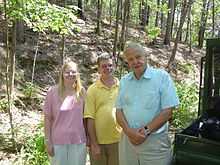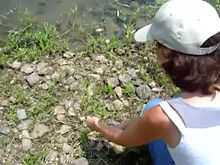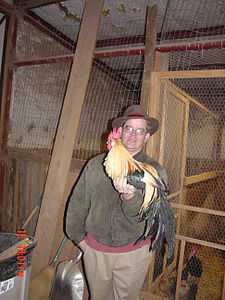Malcolm L. McCallum
| Malcolm L. McCallum | |
|---|---|
|
Malcolm McCallum at his home in Texarkakana circla 2008 with a bantam golden phoenix rooster | |
| Born |
December 26, 1968 Maywood, Illinois |
| Residence | Holden, Missouri, United States |
| Nationality | United States |
| Fields | Biology |
| Institutions | Green Mountain College |
| Alma mater | |

Malcolm L. McCallum (born December 26, 1968 in Maywood, Illinois[1]) is an American environmental scientist, conservationist, herpetologist, and natural historian and is known for identifying that amphibians were going extinct faster than they had during the mass extinction event at the end of the Cretaceous period. He is also a co-founder of the herpetology journal, Herpetological Conservation and Biology.[2] His research has been covered by David Attenborough,[3] Discover Magazine,[4] and other media outlets.
Education, research, teaching and service
.jpg)
In 1997 his discovery of deformed frogs in Madison County, Illinois[5] received media coverage in St. Louis news outlets.[6] He then worked at the St. Louis Children's Aquarium as the institution's grant writer, and designed educational programs, conducted research on the use of bovine somatotropin (bST) applications in aquaculture, and delivered tours and extension programming until he left to pursue his PhD in 1999. He also organized and edited the First International Symposium on the conservation and sustainability of the ornamental fish industry on Rio Negro River, Manaus.[7] He participated in several areas of research that later were published by the aquarium from 1999-2001.[8] Stanley E. Trauth was his doctoral mentor.
Many of his early papers were focused on natural history, but they also cover amphibian conservation, ecological immunology, and general biology. He is widely published on the life history and conservation of Blanchard's cricket frog (Acris blanchardi ) with papers on its systematics, immunology, behavior, life history, and conservation needs. He earned the PhD degree in Environmental Science from Arkansas State University, specializing in ecotoxicology and conservation ecology. He continued this research as an Assistant Professor at Louisiana State University at Shreveport from 2003–2005. As of 2004, he was the fourth most published herpetologist on Arkansas herpetology.[9]
In 2006 McCallum and several other scientists established the journal Herpetological Conservation and Biology.

He moved to Texas A&M University Texarkana in 2005. From 2005 to 2009, he was the only full-time biology professor on staff at the Texarkana campus.[10] When he arrived in 2005, he assessed student performance, redesigned the curriculum, organized a paid intern program, and increased the program's rigor.[10] His changes to the biology program were immediately followed by a thirty-fold growth in student acceptance to medical school and graduate school, and improvement of ETS major field test scores from below the 10th percentile to above the 70th percentile[10] While at Texarkana, he also developed a new teaching method for effectively using scientific articles in discussion settings[11][12]
McCallum used fuzzy logic in his paper, Amphibian decline or extinction? Current losses dwarf background extinction rates,[13] to compare recent extinction rates of amphibians to their rates at the k-Pg boundary. His calculations demonstrated that the losses in amphibian biodiversity in recent times represented one of the most rapid losses in biodiversity ever observed. This study immediately changed the discussion of amphibian declines to a discussion of amphibian extinction.[14] In 2008 the study was listed by Discover Magazine as #4 among ten "landmark papers" on the topic of amphibian extinctions and declines.[4] His use of fuzzy approaches was extended to two studies addressing climate change impacts on herpetofauna.[15][16] These three articles received international attention as important subjects of the United Nations Environmental Program's Panel on the Role of Ecosystem Management in Climate Change Adaptation and Disaster Risk Reduction in 2009.[17]
In 2014 he conducted a study using Google Trends to data mine Google search data to infer public interest on the environment, and concluded that interest in the environment had fallen since 2004.[18] Ficetola responded to this article in a commentary, suggesting that although the proportion of people interested in the environment fell, absolute numbers of searches probably went up.[19] However, that response was rebutted by McCallum[20] responded that even if absolute number of searches was higher, we should still be concerned because "Policy is dictated by proportional popularity, not absolute numbers of individuals." In 2014, this article drew attention as an indicator that international policy goals set by the United Nations to deal with declines in Biodiversity were not being accomplished. The United Nations Convention on Biological Diversity had set a goal to increase public awareness of biological diversity by 2020. Despite this, interest was falling, suggesting that tactics implemented to improve awareness had not been effective.[21]
Academic genealogy
Malcolm L. McCallum graduated with his M.S. in 1994 from Eastern Illinois under Mike Goodrich, and his PHD in 2003 from the Arkansas State University under Stanley E. Trauth. His academic ancestry passes from Trauth (PHD 1980, Auburn University), through Mount (PHD 1962 University of Florida), the eminent ecologist and sea turtle conservationist Archie Carr (PHD 1938, University of Florida), Rogers (PHD 1929 University of Illinois), Stephen Alfred Forbes (PHD 1884 University of Indiana) the first Chief of the Illinois Natural History Survey and a founder of aquatic ecosystem science([22]), the eminent evolutionary biologist and ecologist David Starr Jordan (PHD 1872 Cornell), to Louis Agassiz (PHD 1829 Munich, Germany), the eminent ichthyologist, geologist, and natural historian. McCallum has not advised graduated any PHD students.[23] Michael H. MacRoberts, R. Bruce Bury, Lauren E. Brown, Edward O. Moll, Jerry Farris, Virginia Simions-Lincove (Assoc. Vice Chancelor of Research at LSU-Shreveport), Aldemaro Romero, Jr., and Walter E. Meshaka, Jr. each played important roles in the devolopment of his philosophy of science.[24]
Selected bibliography
McCallum is the author of over 100 publications and Google Scholar reports his citation rating based on the Hirsch Index as h = 9.[25] A herpetologist with his career length has published a mean of 32 +/- 11 publications and an h-score of h = 8.15 +/- 2.4.[26]
- McCallum, M.L. and G.W. Bury (2014). Public interest in the environment is falling: A Response to Ficetola (2013). Biodiversity and Conservation 23:1057-1362.
- McCallum, M.L. and J.L. McCallum. (2014). Ecological Release of an exotic species upon removal of an invasive predator. Journal of North American Herpetology 2014:21 – 27.
- McCallum, M.L., M. Matlock, J. Treas, B. Safi, W. Sanson, J.L. McCallum. (2013). Endocrine disruption of sexual selection by an estrogenic herbicide in Tenebrio molitor. Ecotoxicology 22:1461-1466.
- McCallum, M.L., and G.W. Bury. (2013). Google search patterns suggest declining interest in conservation and environment. Biodiversity and Conservation 22:1355 – 1367.
- McCallum, M.L. 2011. Orientation and directional escape by Blanchard’s Cricket Frog (Acris blanchardi) in response to a human predator. Acta Herpetologica 6(2):161-168.
- McCallum, M.L., C. Brooks, R. Mason, and S.E. Trauth. 2011. Growth, reproduction, and life span in Blanchard’s Cricket Frog (Acris blanchardi) with notes on the growth of the Northern Cricket Frog (Acris crepitans). Herpetology Notes 4:25-35.
- Jones, L., D.R. Gossett, M.L. McCallum, and S.W. Banks. 2010. The antioxidant defense system in tadpoles of the American Bullfrog (Rana catesbeiana) exposed to Paraquat. Journal of Herpetology 44(2):222-228.
- McCallum, M.L. 2010. Future Climate Change Spells Catastrophe for Blanchard’s Cricket Frog, Acris blanchardi (Amphibia, Anura, Hylidae). Acta Herpetologica 5(1):119-130.
- McCallum, M.L. 2010. Characterizing author citation ratings of herpetologists using Harzing’s Publish or Perish. Herpetology Notes 3:239-245.
- McCallum, M. L., J. L. McCallum, and S. E. Trauth. 2009. Predicted climate change may spark box turtle declines. Amphibia-Reptilia 30:259-264.249.
- McCallum, M.L., S. Beharry and S.E. Trauth. 2008. The Central Newt and Ozark Highlands Leech: Müllerian or Aggressive Mimics? Southeastern Naturalist 7(1):173-179
- McCallum, M.L. 2007. Amphibian decline or extinction? Current declines dwarf background extinction rate. Journal of Herpetology 41(3):483-491.
- McCallum, M.L. and S.E. Trauth. 2007. Physiological trade-offs between immunity and reproduction in the northern cricket frog (Acris crepitans). Herpetologica 63(3):269-274.
- McCallum, M.L. and S.E. Trauth. 2006. An Evaluation of the Subspecies Acris crepitans blanchardi (Anura, Hylidae). Zootaxa 1104(1):1-21.
- McCallum, M.L. and J.L. McCallum. 2006. Publication Trends of Natural History and Field Studies in Herpetology. Herpetological Conservation and Biology 1(1):63-68.
- Trauth, S.E., M.L. McCallum, R. Konvalinka, and D.A. Saugey. 2006. Brooding postures and nest site fidelity in the western slimy salamander, Plethodon albagula (Amphibia, Caudata, Plethodontidae), from an abandoned mine shaft in Arkansas. Herpetological Natural History 9(2):141-149.
- McCallum, M.L., S.E. Trauth and R.G. Neal. 2006. Tail-coiling in Ringneck Snakes: Flash display or decoy? Herpetological Natural History 10(1):91-94.
- McCallum, M.L. and S.E. Trauth. 2003. A 43-year museum study of Northern Cricket Frog (Acris crepitans) abnormalities in Arkansas: Upward trends and distributions. Journal of Wildlife Diseases 39(3):522-528.
References
- ↑ Birth Announcements. Joliet Herald News. January 3, 1969
- ↑ Bury, RB, ML McCallum, SE Trauth, and RA Saumure. 2006. Dawning of Herpetological Conservation and Biology: A special welcome to your new journal. Herpetological Conservation and Biology 1(1):i-iii.
- ↑ Life in Cold Blood. "The Land Invaders".
- ↑ 4.0 4.1 Pepitone, Julianne (November 4, 2008). "10 studies that revealed the great global amphibian die-off -- and some possible solutions". Discover Magazine.
- ↑ McCallum, M.L. 1999. Rana sphenocephala (southern leopard frog) malformities found in Illinois with behavioral notes. Transactions of the Illinois State Academy of Science 92:257-264.
- ↑ Kravetz, Andy (1 August 1997). "SIUE pond yields deformed frogs, questions of what they portend". St Louis Post-Dispatch.
- ↑ McCallum, M.L. (Editor). Proceedings of the First International Conference on Biodiversity and Sustainability of the Rio Negro Basin Brazil. Mid-America Aquacenter Publications. St. Louis, Missouri. 1,256 pages. 1999.
- ↑ Conservation for the Oceans. World Aquarium. St. Louis. Activities 1999-2014.
- ↑ Trauth, SE, Robison HW, Plummer MV. The Amphibians and Reptiles of Arkansas. University of Arkansas Press. (see complete bibliography of Arkansas herpetology)
- ↑ 10.0 10.1 10.2 McCallum, M.L. 2014. Improving student achievement through curriculum changes and raised expectations: A case study. Annual Meeting of the Missouri Academy of Science. Warrensburg, MO.
- ↑ McCallum, Malcolm L. (2010). "A Method for Encouraging Classroom Discussion of Scientific Papers". Bulletin of the Ecological Society of America 91 (3): 363–366. doi:10.1890/0012-9623-91.3.363.
- ↑ "Parrots, People and Pedagogies: a look at teaching and education". Living the Scientific Life (Scientist, Interrupted). ScienceBlogs. 16 July 2010.
- ↑ McCallum, M.L. (2007). "Amphibian decline or extinction? Current losses dwarf background rates" (PDF). Journal of Herpetology 41 (3): 483–491. doi:10.1670/0022-1511(2007)41[483:adoecd]2.0.co;2.
- ↑ "Scientists can't explain cause of amphibian extinction crisis". Mongabay. 13 November 2008. Retrieved 8 May 2013.
- ↑ McCallum, M.L., J.L. McCallum, S.E. Trauth. 2009. Predicted climate change may spark box turtle declines. Amphibia-Reptilia 30:259-264.
- ↑ McCallum, M.L. 2010. Future Climate Change Spells Catastrophe for Blanchard’s Cricket Frog, Acris blanchardi (Amphibia, Anura, Hylidae). Acta Herpetologica 5(1):119-130.
- ↑ Munang, R.T. 2009. Questions for policy implementation. Panel on the Role of Ecosystem Management in Climate Change Adaptation and Disaster Risk Reduction. Climate Change Adaptation Unit. Division of Environmental Policy Implementation (DEPI), United Nations Environmental Program (UNEP).
- ↑ McCallum, Malcolm L.; Bury, Gwendolyn W. (2013). "Google search patterns suggest declining interest in the environment". Biodiversity and Conservation 22 (6-7): 1355–1367. doi:10.1007/s10531-013-0476-6.
- ↑ Ficetola, Gentile Francesco (2013). "Is interest toward the environment really declining? The complexity of analysing trends using internet search data" (PDF). Biodiversity and Conservation 22 (12): 2983–2988. doi:10.1007/s10531-013-0552-y.
- ↑ Mc callum ML and Bury. 2014. Public interest in the environment is falling: A response to Ficetola. Biodiversity and Conservation Volume 23, pp 1057-1062
- ↑ Leadley PW, Krug CB, Alkemde R, Pereira HM, Sumaila UR, Walpole M, Marques A Newbold T, Teh LSL, van Kolck J, Bellard C, Januchowski-Hartley SR, and Mumby PJ. 2014. Progress towards the Aichi Biodiversity Targets: An assessment of biodiversity trends, policy scenarios and key actions. Secretariat of the Convention on Biological Diversity, Montreal, Canada. Technical Series 78, 500 pages.
- ↑ Illinois Natural History Survey
- ↑ Adler, Kraig, ed. (2012). Contributions to the History of Herpetology. Volume 3. Vancouver, British Columbia: Society for the Study of Amphibians and Reptiles. ISBN 9780916984823.
- ↑ 10
- ↑ Malcolm L. McCallum. Google Scholar
- ↑ McCallum, M.L. 2010. Characterizing author citation ratings of herpetologists using Harzing’s Publish or Perish. Herpetology Notes 3:239-245.
